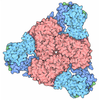[English] 日本語
 Yorodumi
Yorodumi- PDB-2fzk: The Structure of Wild-Type E. Coli Aspartate Transcarbamoylase in... -
+ Open data
Open data
- Basic information
Basic information
| Entry | Database: PDB / ID: 2fzk | ||||||
|---|---|---|---|---|---|---|---|
| Title | The Structure of Wild-Type E. Coli Aspartate Transcarbamoylase in Complex with Novel T State Inhibitors at 2.50 Resolution | ||||||
 Components Components | (Aspartate carbamoyltransferase ...) x 2 | ||||||
 Keywords Keywords | TRANSFERASE / Inhibitors / allosteric transition / Xray structures | ||||||
| Function / homology |  Function and homology information Function and homology informationaspartate carbamoyltransferase complex / pyrimidine nucleotide biosynthetic process / aspartate carbamoyltransferase / aspartate carbamoyltransferase activity / glutamine metabolic process / amino acid binding / protein homotrimerization / 'de novo' UMP biosynthetic process / 'de novo' pyrimidine nucleobase biosynthetic process / zinc ion binding ...aspartate carbamoyltransferase complex / pyrimidine nucleotide biosynthetic process / aspartate carbamoyltransferase / aspartate carbamoyltransferase activity / glutamine metabolic process / amino acid binding / protein homotrimerization / 'de novo' UMP biosynthetic process / 'de novo' pyrimidine nucleobase biosynthetic process / zinc ion binding / identical protein binding / cytoplasm / cytosol Similarity search - Function | ||||||
| Biological species |  | ||||||
| Method |  X-RAY DIFFRACTION / X-RAY DIFFRACTION /  MOLECULAR REPLACEMENT / Resolution: 2.5 Å MOLECULAR REPLACEMENT / Resolution: 2.5 Å | ||||||
 Authors Authors | Heng, S. / Stieglitz, K.A. / Eldo, J. / Xia, J. / Cardia, J.P. / Kantrowitz, E.R. | ||||||
 Citation Citation |  Journal: Biochemistry / Year: 2006 Journal: Biochemistry / Year: 2006Title: T-state Inhibitors of E. coli Aspartate Transcarbamoylase that Prevent the Allosteric Transition. Authors: Heng, S. / Stieglitz, K.A. / Eldo, J. / Xia, J. / Cardia, J.P. / Kantrowitz, E.R. | ||||||
| History |
|
- Structure visualization
Structure visualization
| Structure viewer | Molecule:  Molmil Molmil Jmol/JSmol Jmol/JSmol |
|---|
- Downloads & links
Downloads & links
- Download
Download
| PDBx/mmCIF format |  2fzk.cif.gz 2fzk.cif.gz | 207.2 KB | Display |  PDBx/mmCIF format PDBx/mmCIF format |
|---|---|---|---|---|
| PDB format |  pdb2fzk.ent.gz pdb2fzk.ent.gz | 163.3 KB | Display |  PDB format PDB format |
| PDBx/mmJSON format |  2fzk.json.gz 2fzk.json.gz | Tree view |  PDBx/mmJSON format PDBx/mmJSON format | |
| Others |  Other downloads Other downloads |
-Validation report
| Summary document |  2fzk_validation.pdf.gz 2fzk_validation.pdf.gz | 1.7 MB | Display |  wwPDB validaton report wwPDB validaton report |
|---|---|---|---|---|
| Full document |  2fzk_full_validation.pdf.gz 2fzk_full_validation.pdf.gz | 1.7 MB | Display | |
| Data in XML |  2fzk_validation.xml.gz 2fzk_validation.xml.gz | 52.3 KB | Display | |
| Data in CIF |  2fzk_validation.cif.gz 2fzk_validation.cif.gz | 72.1 KB | Display | |
| Arichive directory |  https://data.pdbj.org/pub/pdb/validation_reports/fz/2fzk https://data.pdbj.org/pub/pdb/validation_reports/fz/2fzk ftp://data.pdbj.org/pub/pdb/validation_reports/fz/2fzk ftp://data.pdbj.org/pub/pdb/validation_reports/fz/2fzk | HTTPS FTP |
-Related structure data
| Related structure data | 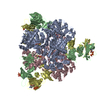 2fzcC 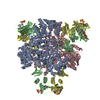 2fzgC  1za2S S: Starting model for refinement C: citing same article ( |
|---|---|
| Similar structure data |
- Links
Links
- Assembly
Assembly
| Deposited unit | 
| ||||||||
|---|---|---|---|---|---|---|---|---|---|
| 1 | 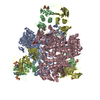
| ||||||||
| Unit cell |
|
- Components
Components
-Aspartate carbamoyltransferase ... , 2 types, 4 molecules ACBD
| #1: Protein | Mass: 34337.105 Da / Num. of mol.: 2 Source method: isolated from a genetically manipulated source Source: (gene. exp.)   #2: Protein | Mass: 17143.625 Da / Num. of mol.: 2 Source method: isolated from a genetically manipulated source Source: (gene. exp.)   |
|---|
-Non-polymers , 4 types, 535 molecules 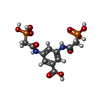

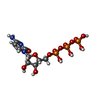




| #3: Chemical | | #4: Chemical | #5: Chemical | #6: Water | ChemComp-HOH / | |
|---|
-Experimental details
-Experiment
| Experiment | Method:  X-RAY DIFFRACTION / Number of used crystals: 1 X-RAY DIFFRACTION / Number of used crystals: 1 |
|---|
- Sample preparation
Sample preparation
| Crystal | Density Matthews: 2.9 Å3/Da / Density % sol: 57.59 % |
|---|---|
| Crystal grow | Temperature: 298 K / Method: microdialysis / pH: 5.7 Details: ATCase holoenzyme was crystallized by microdialysis, using 50 L wells. The enzyme solution, at ~18 mg/mL, was dialyzed against a solution of 40 mM citric acid, 3 mM sodium azide, 1 mM 2- ...Details: ATCase holoenzyme was crystallized by microdialysis, using 50 L wells. The enzyme solution, at ~18 mg/mL, was dialyzed against a solution of 40 mM citric acid, 3 mM sodium azide, 1 mM 2-mercaptoethanol, 1 mM cytidine 5 -triphosphate, 0.2 mM EDTA (pH 5.7), MICRODIALYSIS, temperature 298K |
-Data collection
| Diffraction | Mean temperature: 110 K |
|---|---|
| Diffraction source | Source:  ROTATING ANODE / Type: RIGAKU RU200 / Wavelength: 1.5418 Å ROTATING ANODE / Type: RIGAKU RU200 / Wavelength: 1.5418 Å |
| Detector | Type: RIGAKU RAXIS IV / Detector: IMAGE PLATE / Date: Mar 31, 2005 |
| Radiation | Protocol: SINGLE WAVELENGTH / Monochromatic (M) / Laue (L): M / Scattering type: x-ray |
| Radiation wavelength | Wavelength: 1.5418 Å / Relative weight: 1 |
| Reflection | Resolution: 2.5→28.45 Å / Num. all: 41902 / Num. obs: 41523 / % possible obs: 99.1 % / Observed criterion σ(F): 0 / Observed criterion σ(I): 0 / Redundancy: 4.96 % / Rmerge(I) obs: 0.075 / Net I/σ(I): 13 |
| Reflection shell | Resolution: 2.5→2.59 Å / Redundancy: 4.78 % / Rmerge(I) obs: 0.37 / Mean I/σ(I) obs: 3.9 / Num. unique all: 4143 / % possible all: 99.6 |
- Processing
Processing
| Software |
| |||||||||||||||||||||||||
|---|---|---|---|---|---|---|---|---|---|---|---|---|---|---|---|---|---|---|---|---|---|---|---|---|---|---|
| Refinement | Method to determine structure:  MOLECULAR REPLACEMENT MOLECULAR REPLACEMENTStarting model: pdb entry 1ZA2 Resolution: 2.5→28.45 Å / Cross valid method: THROUGHOUT / σ(F): 0 / σ(I): 0 / Stereochemistry target values: Engh & Huber
| |||||||||||||||||||||||||
| Refinement step | Cycle: LAST / Resolution: 2.5→28.45 Å
|
 Movie
Movie Controller
Controller


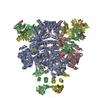
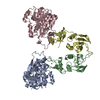
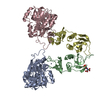


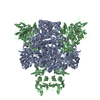
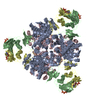
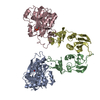
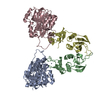

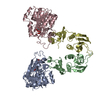
 PDBj
PDBj